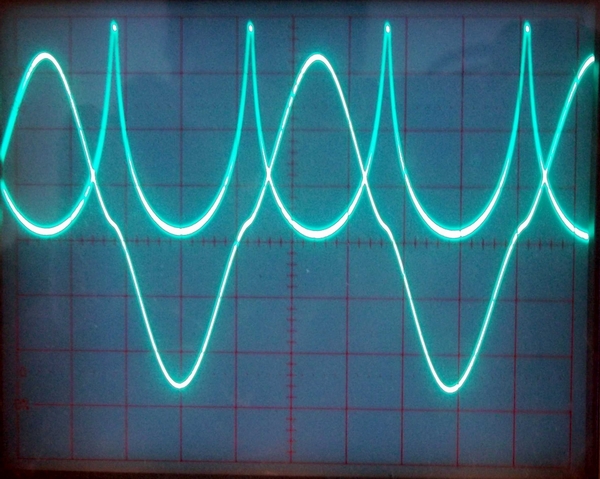I'm not a big fan of over-hyped saturated mixes. They're fatiguing to listen to. I call it "ear burn."
When used in moderation to produce the color a transformer, tube or tape, saturation can add slight warmth and loudness.
Cross a fine line and overuse saturation and it breaks everything, turning the mix into an intermodulated cesspool.
A few years ago I decided to try a couple of VCA-based circuits that provide a degree of control you can't get using a diode clipper.
This allowed me to find what works and what doesn't.
These circuits were works-in-progress: I'm posting them for posterity.
Update August 2023. The Waveulator ME "Mastering Edition," an improved more-transparent version than the original experiments, finally became a reality. viewtopic.php?t=1331
Back to the original 2018 post...
The first saturator has variable threshold and ratio for instrument or mix colorization.
There are two identical channels which are "coupled" using ganged controls. This looks very much like a feed-forward compressor/expander but there is no averaging of the signal. It does not respond to signal history. The waveform is "bent" in real-time with zero-attack zero-release. Its an amplitude modulator: The input modulates itself.

The Waveulator Harmonic Waveform Bender Schematic
Differential modulation of the VCA's Ec+ and Ec- ports greatly reduces "carrier" feedthrough.
The following shows three levels of saturation from soft to hard:

Waveulator Harmonic Waveform Bender Oscillogram
The Waveulator is a zero-attack zero-release limiter:

Waveulator Zero-Attack Zero Release Tone Burst
I later changed to a linear detector which made the unit a little smoother.
The original used a THAT2252 log-scaled detector controlling the THAT2180 VCA's exponential control ports. That makes the overall control slope above threshold linear.
The linear detector shown below causes a more rapid rise in distortion (color) near full-scale but has less effect at lower scale values which are still above threshold. The overall response is exponential.
The linear detector (rectifier) is also non-switching. The op amps do not run open-loop at zero crossing which eliminates "hard corners" in the waveform. Hard corners anywhere sound bad.
The ratio control is also slightly different: The linear version eliminated "expansion" (expansive, odd-order distortion) since it didn't prove to be a useful feature.

Waveulator with a linear detector.
You'll notice that the distortion is odd-order "compressive."
Though it is completely at odds with musical theory I found that even-order didn't sound that good.
With complex material it intermodulates more and breaks down the mix faster.
The intermodulation products folded down into the mix are too dense with even order distortion.
Even-order distortion on solo instruments adds a nice brightness however.
Here's what an ECC83 tube looks like in hard overdrive:

Looks odd-order to me. Just like a transformer, tape head, or tape produce compressive odd-order distortion.
I also did a guitar version using a THAT4316. It needs a threshold circuit added:

The Waveulator guitar version using a THAT4316 and single-supply. It needs a threshold circuit.
FWIW the TL072 is far quieter in this circuit for op amps A and B than the MC33178. I originally chose the '178 for its ultra-low power.
Here's a demo sound file heavy on drums that had the snot compressed out of it using the Waveulator.
The first pass is processed, the second unprocessed. Both are normalized to the same peak value.
Note the huge increase in RMS versus peak level.
Sound file: https://proaudiodesignforum.com/content ... cessed.mp3

Waveulator compressed waveform comparison.
Here's a prototype I did with the late Greg Hanks:

The Waveulator "WMD" "Wavefront Modulation Device."
The Guitar Version:

Waveulator Guitar Version PC Board.








